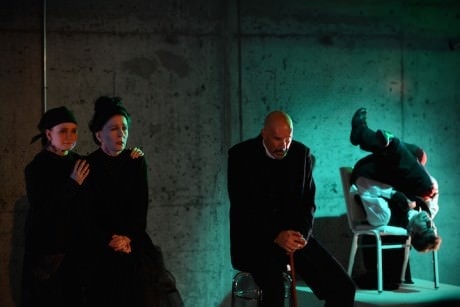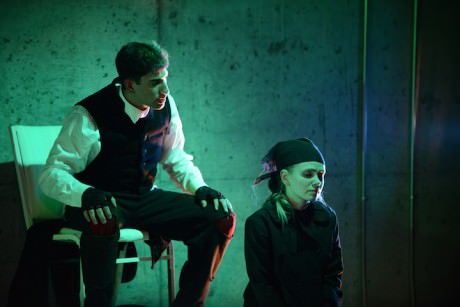As a short story by Franz Kafka awoke one morning from uneasy dreams, it found itself onstage transformed into a live action graphic novel.
Wait, what?

Translation: The adventurous Alliance for New Music-Theatre has been messing around with Metamorphosis—the classic tale of a man who wakes up in his bed having become a big bug. They’ve been adding music, songs and sounds, movement, projected animations, a mixed bag o’ tricks. And the remarkable mashup that results not only aptly captures Kafka’s strange parable of a man utterly estranged, it captivates and fascinates way beyond words.
Inventively adapted and directed by Susan Galbraith from Steven Berkoff’s playscript, this music-theater amalgam is playing for a brief time only in the rehearsal room at Woolly Mammoth Theatre—a suitably stark space enclosed by gray concrete walls, which are put to provocative use as a surface on which to project stylized animations. Designed by Joey Wade and Janet Antich, who have borrowed imaginatively from Kafka’s own minimalist-expressionistic drawings, these projections create a stage world where as an actor mimes lighting candles, white-on-gray flickers of flame appear; where sketched windows and doors may be opened and shut; where a young man who has become a vile insect can put up a portrait he fancies on the wall of his room. The visual interplay between actors and these projected animations, which pop in and out throughout—plus the integration of Kafka’s fabulist prose and artwork—brings a dimension to the storytelling that is both amusing and mesmerizing.
Though the production’s haunting music and unnerving soundscape (designed by Neil McFadden) can probably not be directly attributed to the inspiration of the Czech artist, the effect sometimes gets fabulously Kafkaesque. Contributing composer Hugh Livingston is credited with some of it, and Galbraith has interpolated some traditional Jewish melodies. The cast too has come up with some lively vocal improvisations along with cellist Yvonne Caruthers, who, sitting on a platform stage right during the performance, bows aural pleasures from atonal anguish to the loveliest of sonorities.

This season Alliance for New Music-Theatre has been riffing on what it means to be an outsider, a topic for which Kafka’s Metamorphosis may be the all-time iconic metaphor. The story is set in the home of a Jewish family in the city of Prague, where Kafka spent his alienated youth and where anti-Semitic animus was the norm. In Alliance for New Music-Theatre’s telling retelling, the story’s focus becomes what it means to be an outsider inside one’s own family. Gregor Samsa (Ari Jacobson) is a traveling fabric salesman who dutifully supports his mother (Pamela Bierly-Jusino), father (David Millstone), and sister (Lily Kerrigan). When Gregor metamorphoses into an insect, their life comes apart at the seams, not because something dreadful has befallen their dear son but because their sole breadwinner has become unemployable. As if Gregor’s suffering wasn’t intense enough, his self-referentially resentful mother and father turn on him. Only his sister seems to care how horrible this must be for Gregor.
Jacobson’s angular, contortionist performance could not be more evocative of an outsider’s interior distress. He twists his body into impossible shapes (at one point sitting upside-down in a chair, his shoulders where his butt should be, his arms and legs all akimbo—and then sings that way). He also clambers around on a jumbled gym of ladders—on a set designed by Wade and lit spookily by Brian Allard—like a misshapen creature fleeing insecticidal humans.
In Kafka’s Metamorphosis there comes a point when Gregor tries to speak from inside his locked bedroom to his family and to his boss, who has dropped by to locate the no-show employee. But Gregor’s voice comes out not human. On paper the words he speaks are comprehensible; only Kafka’s notation tells us they’re supposed to sound strange. At the same point in the story as enacted in Alliance for New Music-Theatre’s Metamorphosis, Jacobson enters into an excruciatingly painful dimension that the written word cannot possibly convey. As Jacobson’s gnarled, tormented body struggles, his voice breaks, skips, squeaks, crackles, squeals. His family have not yet seen the creature he has become; they are only learning now it does not sound at all like their meal ticket. They listen stricken, sickened. Just then Jacobson’s performance becomes the epic center of the scene, eliciting horrified fascination from the audience in a tour de force of masterful vocal monstrosity.
Anyone who remembers growing up feeling bugged because they were the black sheep or odd duck in their family will find in Alliance for New Music-Theatre’s marvelously hallucinatory Metamorphosis nice moments of reminiscence.
Running Time: 90 minutes, with no intermission.
Metamorphosis plays through September 21, 2014 at Alliance for New Music-Theatre performing at Woolly Mammoth Theatre Company – 641 D Street NW, in Washington, D.C. For tickets, call (202) 966-3104, or purchase them online.




